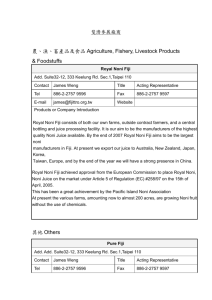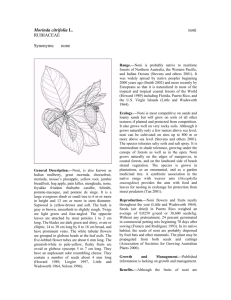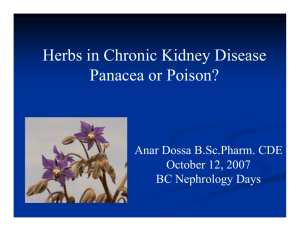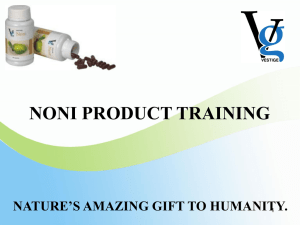Current Research Journal of Biological Sciences 5(4): 177-181, 2013
advertisement
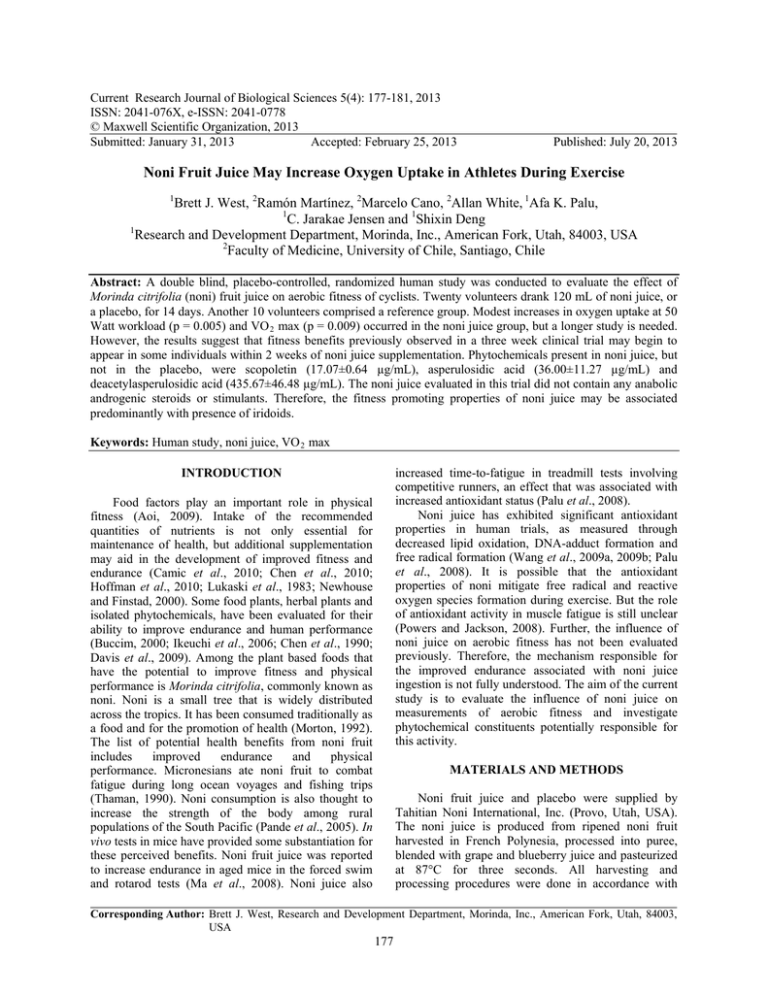
Current Research Journal of Biological Sciences 5(4): 177-181, 2013 ISSN: 2041-076X, e-ISSN: 2041-0778 © Maxwell Scientific Organization, 2013 Submitted: January 31, 2013 Accepted: February 25, 2013 Published: July 20, 2013 Noni Fruit Juice May Increase Oxygen Uptake in Athletes During Exercise 1 Brett J. West, 2Ramón Martínez, 2Marcelo Cano, 2Allan White, 1Afa K. Palu, 1 C. Jarakae Jensen and 1Shixin Deng 1 Research and Development Department, Morinda, Inc., American Fork, Utah, 84003, USA 2 Faculty of Medicine, University of Chile, Santiago, Chile Abstract: A double blind, placebo-controlled, randomized human study was conducted to evaluate the effect of Morinda citrifolia (noni) fruit juice on aerobic fitness of cyclists. Twenty volunteers drank 120 mL of noni juice, or a placebo, for 14 days. Another 10 volunteers comprised a reference group. Modest increases in oxygen uptake at 50 Watt workload (p = 0.005) and VO 2 max (p = 0.009) occurred in the noni juice group, but a longer study is needed. However, the results suggest that fitness benefits previously observed in a three week clinical trial may begin to appear in some individuals within 2 weeks of noni juice supplementation. Phytochemicals present in noni juice, but not in the placebo, were scopoletin (17.07±0.64 µg/mL), asperulosidic acid (36.00±11.27 µg/mL) and deacetylasperulosidic acid (435.67±46.48 µg/mL). The noni juice evaluated in this trial did not contain any anabolic androgenic steroids or stimulants. Therefore, the fitness promoting properties of noni juice may be associated predominantly with presence of iridoids. Keywords: Human study, noni juice, VO 2 max increased time-to-fatigue in treadmill tests involving competitive runners, an effect that was associated with increased antioxidant status (Palu et al., 2008). Noni juice has exhibited significant antioxidant properties in human trials, as measured through decreased lipid oxidation, DNA-adduct formation and free radical formation (Wang et al., 2009a, 2009b; Palu et al., 2008). It is possible that the antioxidant properties of noni mitigate free radical and reactive oxygen species formation during exercise. But the role of antioxidant activity in muscle fatigue is still unclear (Powers and Jackson, 2008). Further, the influence of noni juice on aerobic fitness has not been evaluated previously. Therefore, the mechanism responsible for the improved endurance associated with noni juice ingestion is not fully understood. The aim of the current study is to evaluate the influence of noni juice on measurements of aerobic fitness and investigate phytochemical constituents potentially responsible for this activity. INTRODUCTION Food factors play an important role in physical fitness (Aoi, 2009). Intake of the recommended quantities of nutrients is not only essential for maintenance of health, but additional supplementation may aid in the development of improved fitness and endurance (Camic et al., 2010; Chen et al., 2010; Hoffman et al., 2010; Lukaski et al., 1983; Newhouse and Finstad, 2000). Some food plants, herbal plants and isolated phytochemicals, have been evaluated for their ability to improve endurance and human performance (Buccim, 2000; Ikeuchi et al., 2006; Chen et al., 1990; Davis et al., 2009). Among the plant based foods that have the potential to improve fitness and physical performance is Morinda citrifolia, commonly known as noni. Noni is a small tree that is widely distributed across the tropics. It has been consumed traditionally as a food and for the promotion of health (Morton, 1992). The list of potential health benefits from noni fruit includes improved endurance and physical performance. Micronesians ate noni fruit to combat fatigue during long ocean voyages and fishing trips (Thaman, 1990). Noni consumption is also thought to increase the strength of the body among rural populations of the South Pacific (Pande et al., 2005). In vivo tests in mice have provided some substantiation for these perceived benefits. Noni fruit juice was reported to increase endurance in aged mice in the forced swim and rotarod tests (Ma et al., 2008). Noni juice also MATERIALS AND METHODS Noni fruit juice and placebo were supplied by Tahitian Noni International, Inc. (Provo, Utah, USA). The noni juice is produced from ripened noni fruit harvested in French Polynesia, processed into puree, blended with grape and blueberry juice and pasteurized at 87°C for three seconds. All harvesting and processing procedures were done in accordance with Corresponding Author: Brett J. West, Research and Development Department, Morinda, Inc., American Fork, Utah, 84003, USA 177 Curr. Res. J. Biol. Sci., 5(4): 177-181, 2013 good agricultural practices and good manufacturing practices. For the clinical trial, a placebo was prepared by blending grape and blueberry juice with a natural cheese flavor, to mimic the flavor of the blended noni juice. The placebo also served as a common fruit juice comparison. Noni juice and placebo were filled in green colored glass bottles. A colored sticker was placed on the cap of each bottle. The colors were coded for either noni juice or placebo. Participants and researchers were blinded to treatment, as the color coding was not revealed until after the study was completed and data analyzed. Replicate samples of noni juice and placebo were analyzed for phytochemical composition. The iridoid content of the samples, inclusive of Deacetylasperulosidic Acid (DAA) and Asperulosidic Acid (AA), were determined by HPLC, according to a previously reported method (Deng et al., 2011). HPLC grade acetonitrile (MeCN), methanol (MeOH) and water were obtained from Sigma-Aldrich (St. Louis, MO, USA). Analytical grade formic acid was purchased from Spectrum Chemical Mfg. Corp. (New Brunswick, NJ, USA). Deacetylasperulosidic Acid (DAA) and Asperulosidic Acid (AA) standards were isolated from authentic noni fruit in our laboratory. Their identification and purities were determined by HPLC, mass spectrometry and Nuclear Magnetic Resonance (NMR) to be higher than 99%. They were accurately weighed and then dissolved in an appropriate volume of MeOH to produce corresponding stock solutions. The working standard solutions of DAA and AA for the calibration curve were prepared by diluting stock solutions with MeOH in seven concentration increments ranging from 0.00174-1.74 and 0.0016-0.80 mg/mL, respectively. All stock and working solutions were maintained at 0°C. The calibration curves of the standards were plotted after linear regression of the peak areas versus concentrations. For iridoid analyses, samples of noni juice and placebo were diluted with MeOH-H 2 O (1:1) and then filtered through a 0.45 µm nylon membrane filter. Chromatographic separation was performed on a Waters 2690 separations module coupled with 996 PDA detectors, equipped with a C18 column (4.6×250 mm; 5 μm, Waters Corporation, Milford, MA, USA). The pump was connected to two mobile phases: A; MeCN and B; 0.1% formic acid in H 2 O (v/v) and eluted at a flow rate of 0.8 mL/min. The mobile phase was programmed consecutively in linear gradients as follows: 0-5 min, 0% A; and 40 min, 30% A. The PDA detector was monitored in the range of 210-400 nm. The injection volume was 10 µL for each of the sample solutions. The column temperature was maintained at 25°C. Data collection and integration were performed using Waters Millennium software revision 32. Analyses of scopoletin, rutin, quercetin and chlorogenic acid were also performed by HPLC, according to a previously reported method (Deng et al., 2010). Chemical standards were accurately weighed and then dissolved in an appropriate volume of MeOH/MeCN to produce corresponding stock and working standard solutions. Chromatographic separation was performed on a Waters 2690 separations module coupled with a 996 Photodiode Array (PDA) detector and equipped with a C18 column. The mobile phase system was composed of three solvents: A; MeCN, B; MeOH and C; 0.1% TFA in H 2 O (v/v). The mobile phase was programmed consecutively in linear gradients as follows: 0 min, 10% A, 10% B and 80% C; 15 min, 20% A, 20% B and 60% C; 26 min, 40% A, 40% B and 20% C; 28-39 min, 50% A, 50% B and 0% C; and 40-45 min, 10% A, 10% B and 80% C, respectively. The elution was run at a flow rate of 1.0 mL/min. The UV spectra were quantified at 365 nm. Total polyphenols were determined by the FolinCiocalteu method (Yang et al., 2007). Samples were centrifuged and diluted 1:10 with deionized water. The diluted samples (10 µL) were mixed with 800 µL deionized water and 50 µL Folin-Ciocalteu (2N). Following incubation at room temperature for a few minutes, 150 µL Na 2 CO 3 (saturated) was added, sample tubes shaken and allowed to incubate at room temperature for 2 h. Vehicle blanks and gallic acid standards were prepared in the same manner. Following incubation, the absorbance of the blanks, standards and samples were measured at 765 nm in a microplate reader. Absorbance vs. gallic acid concentration was used to create a calibration curve. This curve was used determined the total phenol content of the samples. Independent analysis of noni juice for performance enhancing substances, including anabolic androgenic steroids and stimulants, was performed at the Center for Preventive Doping Research, German Sports University, Cologne, Germany, under the direction of Maria Kristina Parr. Chemical analyses were specific for 19-nor-4-androstene-3β, 17β-diol, 19-nor-5androstene-3β, 17β-diol and 19-nor-4-androstene-3, 17dione, 19- nortestosterone, 4-Androstene-3β, 17β-diol, 5 Androstene-3β, 17β-diol, 4-Androstene-3, 17-dione, Dehydroepiandrosterone (DHEA), testosterone, 5aandrostan-3β, 17β-diol androstadien-3, 17-dione, amphetamine, metamphetamine, dimetamphetamine, methylenedioxoamphetamine, methylephedrine, methylpseudoephedrine, ephedrine, pseudoephedrine, norephedrine, norpseudoephedrine, strychnine, methylenedioxometamphetamine, methylenedioxoethylamphetamine, benzphetamine and fenfluramine. Thirty semiprofessional male cyclists, ages 18 to 50 years, were enrolled in the trial. All athletes frequently participated in road race competitions. These volunteers were randomly assigned to three groups consisting of 10 individuals each; a noni juice treatment group, placebo group and an untreated reference control 178 Curr. Res. J. Biol. Sci., 5(4): 177-181, 2013 group that did not consume noni juice or placebo. Those in the noni juice and placebo groups were instructed to drink 60 mL twice/day (every 12 h, morning and evening) for 14 days. All volunteers continued their normal training during the study and were evaluated one week before and immediately after the noni juice or placebo consumption period (day 14). The untreated control group was evaluated at the same time as the other two groups. Each participant was subjected to an exercise test on a cycle ergometer with a workload increase of 30 watts/min to the point of exhaustion, electrocardiographic alterations, or to the theoretical maximal heart rate (220 beats/min minus age in years). This test was performed at baseline and at the end of the trial. Baseline and post-trial measurements included body weight, resting heart rate, maximal heart rate, oxygen uptake at rest (VO 2 rest), oxygen uptake at 50 watts workload (VO 2 50 Watt) and maximal oxygen uptake (VO 2 max). Oxygen uptake was determined by the analysis of expired O 2 and CO 2 with a spirometer (Vmax Spectra, SensorMedics, Yorba Linda, California, USA). Heart rate was monitored by 3-lead electrocardiography. Baseline and post-trial laboratory measurements of blood lactate, hematocrit, protein and glucose were made at rest (pre-exercise), immediately following the exercise test and 50 min post exercise. Plasma protein concentration was measured by refractometry (Thoene et al., 1967). Blood lactate was measured with the Accusport® lactate meter (Boehringer Mannheim, Germany) and BM-lactate strips (Fell et al., 1998). Blood glucose was also measured with a portable glucometer (Accutrend®, Roche Diagnostics, Mannheim, Germany) and glucose strips (Chan et al., 1997). The Kruskal-Wallis test and Student’s t-test were performed to evaluate inter and intra-group differences. The human study protocol was approved following ethics committee review. Prior to enrollment, each volunteer received oral and written information about the study procedures and was required to sign a participation acceptance document ("Informed Consent") obtained from the Ethics Committee on Research in Humans from the University of Chile faculty of medicine. noni juice is much greater than that of the placebo. Noni juice did not contain any detectable quantities of anabolic androgenic steroids and stimulants. Baseline and post-trial body weights, as well as resting and maximal heart rates, are compared in Table 2. There appears to be a trend in reduced resting and maximal heart rates in all groups. However, the differences are not statistically significant. Baseline and post-trial laboratory measurements of blood lactate, hematocrit, protein and glucose are compared in Table 3. There were no significant changes in any of these parameters in any of the groups at rest (preexercise), immediately following the exercise test, or 50 min post exercise. The single exception to this is an increase in blood lactate levels in the placebo group immediately after exercise from 4.9±1.6 to 6.3±1.6 mM (p = 0.01). However, there was no difference in this measurement between the three groups. Oxygen uptake rates, especially VO 2 max, are measurements of cardiovascular fitness. Increases in measured oxygen uptake are an indication of improved cardiovascular fitness. Following the 14 day supplementation period, two changes in oxygen uptake were observed in the noni group, Fig. 1. Intragroup comparisons revealed that average oxygen uptake at 50 watt workload increased in the noni juice group from 15.2 to 17.4 mL/kg/min (p = 0.005). No significant increases in VO 2 50 Watt were evident in the other groups. An average increase in maximal oxygen consumption from 51.5 to 55.0 mL/kg/min (p = 0.009) was also seen in the noni juice group. No significant changes were observed in the other groups, with the exception of a decreased resting VO 2 in the placebo group. Changes from baseline in VO 2 50 Watt and VO 2 max, within the noni juice group, were statistically significant only when intragroup comparisons were made. RESULTS AND DISCUSSION Table 1: Phytochemical and nutritional contents of noni juice and placebo (mean±standard deviation) Analysis Noni juice Placebo Chlorogenic acid (µg/mL) 119.83±21.29 43.77±0.15* Scopoletin (µg/mL) 17.07±0.64 None detected* Rutin (µg/mL) 43.63±1.42 6.53±0.12* Quercetin (µg/mL) 3.57±0.12 1.74±0.01* Deacetylasperulosidic acid 435.67±46.48 None detected* (µg/mL) Asperulosidic acid (µg/mL) 36.00±11.27 None detected* Total polyphenols (µg/mL) 1067.07±108.09 644.72±91.11* *: p<0.01 The phytochemical compositions of the noni juice and placebo samples are compared in Table 1. There was no significant difference in total polyphenol contents. There are, however, notable differences in the contents of other phytochemicals in the noni juice and placebo samples. As expected, the noni fruit specific phytochemicals, such as scopoletin, deacetylasperulosidic acid and asperulosidic acid, were not detected in the placebo. The total iridoid content of Table 2: Weight and heart rates, pre and post-trial (mean±standard deviation) Resting Maximal heart rate heart rate Weight (beats/min) (beats/min) Group (kg) Placebo Baseline 69.4±7.1 65.4±9.3 172.6±10.3 Post-trial 70.5±5.6 60.5±6.6 167.8±12.8 Noni juice Baseline 71.4±9.7 68.1±6.8 180.6±12.5 Post-trial 71.1±9.5 66.9±4.3 178.9±13.1 Untreated Baseline 75.1±11.0 64.1±7.7 175.4±11.5 Post-trial 75.9±11.2 62.7±10.4 171.1±16.7 179 Curr. Res. J. Biol. Sci., 5(4): 177-181, 2013 Table 3: Laboratory measurements, pre and post-trial (mean±standard deviation) Placebo Noni juice ------------------------------------------------ ---------------------------------------------Blood sampling time Baseline Post-trial Baseline Post-trial Lactate (mM) Resting 2.6±0.7 2.4±0.5 2.4±0.5 3.1±0.9 Post exercise 4.9±1.6 6.3±1.6* 5.9±1.4 6.6±1.8 50 min. post exercise 2.7±0.6 2.3±1.0 2.9±0.9 2.6±0.7 Glucose (mg/dL) Resting 99.0±15.5 93.7±10.8 90.7±33.3 94.9±20.5 Post exercise 102.0±10.9 101.8±12.8 105.1±14.7 84.0±14.3 50 min. post exercise 98.8±11.0 99.0±15.8 96.0±7.3 93.9±19.9 Hematocrit (%) Resting 46.2±2.7 45.8±3.4 45.9±2.2 45.0±1.7 Post exercise 48.7±3.1 49.2±2.7 48.6±2.0 47.9±1.9 50 min. post exercise 45.8±2.8 45.4±2.8 45.2±2.8 43.8±1.3 Plasma protein (g/dL) Resting 7.6±0.6 7.2±0.3 7.7±0.4 7.4±0.5 Post exercise 8.1±0.4 8.0±0.4 8.3±0.6 8.1±0.7 50 min. post exercise 7.4±0.4 7.3±0.4 6.7±2.6 7.2±0.5 *: p = 0.01, Compared to baseline Untreated ---------------------------------------Baseline Post-trial 2.6±0.7 7.0±2.4 2.1±0.6 2.9±1.3 7.8±2.3 2.2±0.4 92.7±6.6 100.0±9.1 101.4±13.2 96.8±10.6 92.0±22.0 91.7±10.3 45.9±2.9 49.5±3.3 45.4±2.9 45.4±3.0 49.2±2.5 45.0±2.8 7.3±0.4 8.0±0.5 7.1±0.4 7.3±0.4 7.9±0.4 7.0±0.5 of noni juice on oxygen uptake, involving longer periods of time and larger numbers of participants, are warranted. Even so, the current findings might indicate that the fitness promoting effects of noni juice begin to appear in some individuals within two weeks of supplementation. ACKNOWLEDGMENT This study was funded by Morinda, Inc. (Provo, Utah, U.S.A.). Fig. 1: Pre and post-trial oxygen uptake at 50 watt workload (VO 2 50 Watt) and maximal oxygen uptake (VO 2 max) in the noni juice group *: p = 0.005; **: p = 0.009; Compared to intra group baseline REFERENCES Akinbo, S.R.A., C.C. Noronha, A.O. Okanlawonand and M.A. Danesi, 2006. Comparative study of the effect of Morinda citrifolia (noni) with selected physiotherapy modalities in the management of patients with cervical spondylosis. Niger. J. Health Biomed. Sci., 5: 6-11. Aoi, W., 2009. Exercise and food factors. Forum Nutr., 61: 147-155. Buccim, L.R., 2000. Selected herbals and human exercise performance. Am. J. Clin. Nutr., 72: 624S-636S. Camic, C.L., T.J. Housh, J.M. Zuniga, R.C. Hendrix, M. Mielke, G.O. Johnson and R.J. Schmidt, 2010. Effects of arginine-based supplements on the physical working capacity at the fatigue threshold. J. Strength Cond. Res., 24: 1306-1312. Chan, J.C., R.Y. Wong, C.K. Cheung, P. Lam, C.C. Chow, V.T. Yeung, E.C. Kan, K.M. Loo, M.Y. Mong and C.S. Cockram, 1997. Accuracy, precision and user-acceptability of self blood glucose monitoring machines. Diabetes Res. Clin. Pr., 36: 91-104. Chen, J.D., Z.Y. Yang, S.H. Ma and Y.C. Zhen, 1990. The effects of actinidiasinensis planch (kiwi) drink supplementation on athletes training in hot environments. J. Sport. Med. Phys. Fit., 30: 181-184. CONCLUSION The results of the current study reveal a possible increase in aerobic fitness while consuming noni juice. However, the increase seen over the two week period was modest. A previous treadmill endurance test with runners demonstrated a 21% increase in average timeto-fatigue (Palu et al., 2008), which was associated with a significant decrease in biomarkers of lipid peroxidation. While it is possible that antioxidant properties may be responsible for the endurance promoting properties of noni juice, it must be kept in mind that such effects have been seen only after 3 weeks of noni juice supplementation. Further, improved endurance in mice was seen only after 3 weeks of noni juice ingestion (Ma et al., 2008). Other human studies have reported positive health effects from noni juice only after 4 weeks or more of supplementation (Akinbo et al., 2006; Langford et al., 2004). The most prominent phytochemicals in noni juice are iridoids and other human trials with iridoid containing plants also reveal the need for longer supplementation periods (Perrinjaquet-Moccetti et al., 2008; Liang et al., 2003). Therefore, it is likely that current study was too short to reveal more significant increases in oxygen uptake. These results suggest that further studies of the effects 180 Curr. Res. J. Biol. Sci., 5(4): 177-181, 2013 Chen, S., W. Kim, S.M. Henning, C.L. Carpenter and Z. Li, 2010. Arginine and antioxidant supplement on performance in elderly male cyclists: A randomized controlled trial. J. Int. Soc. Sport. Nutr., 7: 13. Davis, J.M., E.A. Murphy, M.D. Carmichael and B. Davis, 2009. Quercetin increases brain and muscle mitochondrial biogenesis and exercise tolerance. Am. J. Physiol. Regul. Integr. Comp. Physiol., 296: R1071-1077. Deng, S., B.J. West and C.J. Jensen, 2010. A quantitative comparison of phytochemical components in global noni fruits and their commercial products. Food Chem., 122: 267-270. Deng, S., B.J. West, A.K. Palu and C.J. Jensen, 2011. Determination and comparative analysis of major iridoids in different parts and cultivation sources of Morinda citrifolia. Phytochem. Anal., 22: 26-30. Fell, J.W., J.M. Rayfield, J.P. Gulbin and P.T. Gaffney, 1998. Evaluation of the Accusportlactate analyser. Int. J. Sport. Med., 19: 199-204. Hoffman, J.R., N.A. Ratamess, J. Kang, S.L. Rashti, N. Kelly, A.M. Gonzalez, M. Stec, A. Anderson, B.L. Bailey, L.M. Yamamoto, L.L. Hom, B.R. Kupchak, A.D. Faigenbaum and C.M. Maresh, 2010. Examination of the efficacy of acute L-alanyl-L-glutamine ingestion during hydration stress in endurance exercise. J. Int. Soc. Sport. Nutr., 3(7): 8. Ikeuchi, M., K. Yamaguchi, T. Koyama, Y. Sono and K. Yazawa, 2006. Effects of fenugreek seeds (Trigonellafoenumgreaecum) extract on endurance capacity in mice. J. Nutr. Sci. Vitaminol., 52: 287-292. Langford, J., A. Doughty, M. Wang, L. Clayton and M. Babich, 2004. Effects of Morinda citrifolia on quality of life and auditory function in postmenopausal women. J. Alt. Complem. Med., 10: 737-739. Liang, R., M.R. Chen and X. Xu, 2003. Effect of dandi tablet on blood lipids and sex hormones in women of postmenopausal stage. ZhongguoZhong Xi Yi Jie He ZaZhi, 23:593-595. Lukaski, H.C., W.W. Bolonchuk, L.M. Klevay, D.B. Milne and H.H. Sandstead, 1983. Maximal oxygen consumption as related to magnesium, copper and zinc nutriture. Am. J. Clin. Nutr., 37: 407-415. Ma, D., Z. Jun, G. Jianhua et al., 2008. The effect of Tahitian noni juice on antioxidation and immune function. Chinese Med. Res. Clin., 6: 8-10. Morton, J.F., 1992. The ocean going noni, or Indian Mulberry (Morinda citrifolia, Rubiaceae) and some of its 'colorful' relatives. Econ. Bot., 46: 241-256. Newhouse, I.J. and E.W. Finstad, 2000. The effects of magnesium supplementation on exercise performance. Clin. J. Sport Med., 10: 195-200. Palu, A.K., R.D. Seifulla and B.J. West, 2008. Morinda citrifolia L. (noni) improves athlete endurance: Its mechanisms of action. J. Med. Plant Res., 2: 154-158. Pande, M., M. Naiker, G. Mills, N. Singh and T. Voro, 2005. The Kura files: Qualitative social survey. Pac. Health Dialog, 12: 85-93. Perrinjaquet-Moccetti, T., A. Busjahn, C. Schmidlin, A. Schmidt, B. Bradl and C. Aydogan, 2008. Food supplementation with an olive (Oleaeuropaea L.) leaf extract reduces blood pressure in borderline hypertensive monozygotic twins. Phytother. Res., 22: 1239-1242. Powers, S.K. and M.J. Jackson, 2008. Exercise-induced oxidative stress: Cellular mechanisms and impact on muscle force production. Physiol. Rev., 88: 1243-1276. Thaman, R.R., 1990. Kiribati agroforestry: Trees, people and the atoll environment. Atoll Res. Bull., 333: 1-29. Thoene, J.G., J.L. Talbert, S. Subramanian and G.B. Odell, 1967. Use of the hand refractometer in determining total serum proteins of infants and children. J. Pediatr., 71: 413-417. Wang, M.Y., L. Peng, M.N. Lutfiyya, E. Henley, V. Weidenbacher-Hoper and G. Anderson, 2009a. Morinda citrifolia (noni) reduces cancer risk in current smokers by decreasing aromatic DNA adducts. Nutr. Cancer, 61: 634-639. Wang, M.Y., M.N. Lutfiyya, V. Weidenbacher-Hoper, G. Anderson, C.X. Su and B.J. West, 2009b. Antioxidant activity of noni juice in heavy smokers. Chem. Cent. J., 3(13): 1-5. Yang, J., R. Paulino, S. Janke-Stedronsky and F. Abawi, 2007. Free-radical-scavenging activity and total phenols of noni (Morinda citrifolia L.) juice and powder in processing and storage. Food Chem., 102: 302-308. 181
